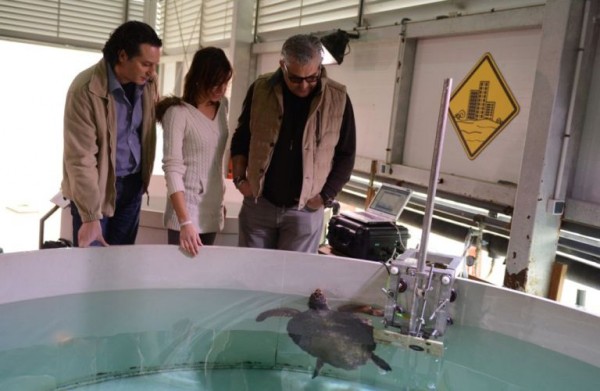Sonars and echo sounders are commonly used to detect and assess fish stock, as well as for species identification. However, there are very few studies of turtle populations made with these tools, probably due to a lack of commercial interest. Now a team of researchers from the Campus of Gandia and the Oceanogràfic in Valencia are working on a new side scan sonar configuration that will allow them to identify the “acoustic echo” produced by turtles, which would help to conduct a census of the species
The side scan sonar is most often used for the detection of objects on the sea floor. The acoustic reflections of the shadows made by the objects found on the sea bottom are recorded and processed to provide an image of the sea floor. This system configuration was tested on turtles, but the initial results were not very good; even when the presence of turtles on the sea floor had been confirmed, they were often mistaken for rocks.
The new proposed configuration of the sonar places the emitter almost on the surface, focusing the beam like a curtain beneath it. “We observed the acoustic data before receiving the first echo from the bottom. This way, our proposal allows the detection of not only the specimens on land, but also the ones swimming in the water column, something that is totally new,” according to Isabel Pérez, a researcher at the Campus of Gandia.
Characterizing the acoustic response of turtles and distinguishing it from other species will enable the identification, location and quantification of the individuals, providing a useful tool for associations, scientific groups and pertinent authorities. This could result in censuses of sea turtles at controlled costs which would improve on the censuses that are carried out today, based on data from by-catch and aerial sightings.
“The use of this methodology to detect sea turtles through active acoustics can be a valuable tool both for early detection, and for obtaining the first estimates of the number of animals in places of high concentration, such as nesting beaches,” highlights José Antonio Esteban, head of the Oceanogràfic Research Department.
Researchers at the UPV have already taken the first measurements of acoustic signals from live turtles swimming in open water during the release of animals recovered by the ARCA del Mar of the Oceanogràfic in Valencia.
The echo sounder emits, captures and processes the echoes produced, whose intensity depends, for example, on the size and number of fish, but also on the type of species, since their physical makeup is a key element when dispersing sound. In the case of turtles, researchers expect that their special anatomy (shell, lungs, etc.) to provide a greater echo than the one produced by large fish, and with a different structure than the echo produce by dolphins and other marine mammals.
The Campus of Gandia, through the IGIC, has spent the last four years working on the detection, tagging and census of different marine species in collaboration with various national and international institutions to improve species monitoring and to identify some key biological and behavioral aspects.


